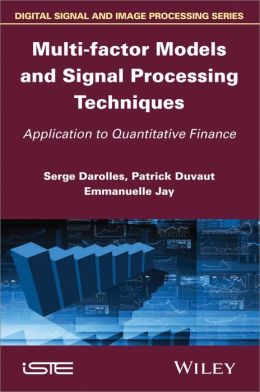 [内容简介]
[内容简介]
With recent outbreaks of multiple large-scale financial crises, amplified by interconnected risk sources, a new paradigm of fund management has emerged. This new paradigm leverages “embedded” quantitative processes and methods to provide more transparent, adaptive, reliable and easily implemented “risk assessment-based” practices.
This book surveys the most widely used factor models employed within the field of financial asset pricing. Through the concrete application of evaluating risks in the hedge fund industry, the authors demonstrate that signal processing techniques are an interesting alternative to the selection of factors (both fundamentals and statistical factors) and can provide more efficient estimation procedures, based on lq regularized Kalman filtering for instance.
With numerous illustrative examples from stock markets, this book meets the needs of both finance practitioners and graduate students in science, econometrics and finance.
[目录]
Foreword xi
Rama CONT
Introduction xv
Notations and Acronyms xxi
Chapter 1. Factor Models and General Definition 1
1.1. Introduction 1
1.2. What are factor models? 2
1.3. Why factor models in finance? 7
1.4. How to build factor models? 11
1.5. Historical perspective 14
1.6. Glossary 18
Chapter 2. Factor Selection 23
2.1. Introduction 23
2.2. Qualitative know-how 24
2.3. Quantitative methods based on eigenfactors 31
2.4. Model order choice 36
2.5. Appendix 1: Covariance matrix estimation 38
2.6. Appendix 2: Similarity of the eigenfactor selection with the MUSIC algorithm 46
2.7. Appendix 3: Large panel data 48
2.8. Chapter 2 highlights 56
Chapter 3. Least Squares Estimation (LSE) and Kalman Filtering (KF) for Factor Modeling: A Geometrical Perspective 59
3.1. Introduction 59
3.2. Why LSE and KF in factor modeling? 60
3.3. LSE setup 62
3.4. LSE objective and criterion 63
3.5. How LSE is working (for LSE users and programmers) 64
3.6. Interpretation of the LSE solution . 65
3.7. Derivations of LSE solution 70
3.8. Why KF and which setup? 71
3.9. What are the main properties of the KF model? 74
3.10. What is the objective of KF? 76
3.11. How does the KF work (for users and programmers)? 77
3.12. Interpretation of the KF updates 81
3.13. Practice 86
3.14. Geometrical derivation of KF updating equations 104
3.15. Highlights 112
3.16. Appendix: Matrix inversion lemma 116
Chapter 4. A Regularized Kalman Filter (rgKF) for Spiky Data 117
4.1. Introduction 117
4.2. Preamble: statistical evidence on the KF recursive equations 119
4.3. Robust KF 119
4.4. rgKF: the rgKF(NG,lq ) 121
4.5. Application to detect irregularities in hedge fund returns 128
4.6. Conclusion 130
4.7. Chapter highlights 130
Appendix: Some Probability Densities 133
Conclusion 141
Bibliography 143
Index 153

 新书报道
新书报道